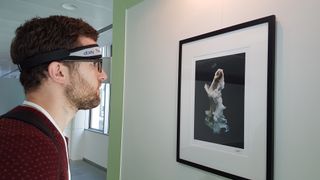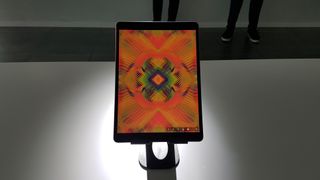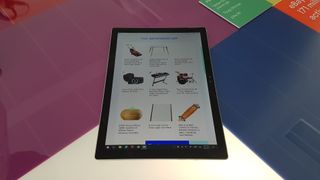Ebay made me look at art, then told me what my subconscious wanted to buy
Drumkits and keyboards mostly

I’m stood in a central London location, an electroencephalogram strapped to my head while I stare at a piece of art. No this isn’t A Clockwork Orange, I’m actually shopping. Or my subconscious is. I think.
In an effort to ‘combat beige shopping’, Ebay has set up an interactive experience that uses real-time brain wave scans to try and get you to think about your motivations for the items you choose.
The process starts by getting strapped up, a headband wrapped around your head and a clip attached to your earlobe. You then fill out a form that includes numerous questions including ones about your age and gender (which we imagine may have also had an influence on our final product suggestions).
Next, you're taken into a room with a row of iPads and taken through a series of tests to get base brain readings. First up is brain training, where you have to choose which is the highest of two numbers, with increasing difficulty. I get the first few in and I’m feeling pretty good. 12 is higher than 11. Winner.
It gets more difficult as it goes on, and the fact that there’s a man hovering nearby looking at my brain waves makes me more than a little ashamed when I struggle to figure out 24 divided by two versus 11.

Next up is a racing game, followed by a colorful pattern creator. Basically one for focus, one for visual strategy, one for creativity. So we can identify the Lion, the Scarecrow and the Tin Man. If I only had a brain.
Using these three tests, the brain scan can figure out which part of my brain is being stimulated by what I'm looking at. Now, on to the art!
Get the best Black Friday deals direct to your inbox, plus news, reviews, and more.
Sign up to be the first to know about unmissable Black Friday deals on top tech, plus get all your favorite TechRadar content.
How very cultured
The art gallery, generously provided by Saatchi Art, was full of different art styles in different mediums. You take at least 20 seconds looking at each piece, then your subconscious response is fed back to the iPad.
The art was great, and I had a lovely time wandering around looking at it all. I was a little self conscious knowing there was a man stood a couple of meters away looking at readings of how my brain was reacting, but it was a very nice way to spend a part of my morning.

I particularly liked this piece that looked like a peaceful wooded scene, but was digitally created with lots of repetition, and on closer inspection each of the colors was labelled like a Painting by Numbers picture.
On to the shopping!
So I finished looking at the art, my EEG was taken off, and my shopping list populated. Apparently I was most focused on the visual themes of the images rather than being creatively inspired by them, which I suppose is true, and has made me question the way I look at art.
My passion for the wooded picture populated an aroma diffuser, and my interest in another piece that was a world map painted across some speakers populated a drum kit and keyboard.
It obviously didn’t pick up on the fact that I was looking at that piece because I was trying to figure out if the map had been drawn with geographic accuracy and was looking at the landmass of Africa versus my own tiny island. I know, I'm super cool.

The shopping cart was interesting. It was full of musical instruments, cameras, skateboards, stylish interiors, and it felt like it painted a specific picture of a person. The only problem is, that person isn’t me. It could be, and there’s a part of me that would like to skateboard, play the drums, be a photographer, but I’m not.
But maybe that’s not the end of the world. We sat down for a chat with Ebay’s Head of Personalization and Engagement, Bradford Shellhammer (yes that is his real name), to talk about how this experience will actually affect consumers at home.
“What’s here is not affecting consumers. Thematically it lines up quite nicely with the work we’re doing in the real world, but today was really just to get people to talk about shopping more thoughtfully, or more emotionally, or just not playing it safe.”
And that’s the real point here. Many times during the morning we heard the phrase ‘shop-y-cat’ being thrown around, which as well as probably garnering its progenitor many pats on the back, refers to how most us probably shop.

We buy something because it’s ‘on trend’ or because someone we know has one, or there’s a recommendation. Ebay is clearly pushing for people to make more ‘inspired’ purchases. Which makes sense, as thinking outside the box is a must for a retailer that essentially sells anything within reason.
This experience does tie into something that Ebay has been working on since January, that as Shellhammer puts it: “[Is about] showing you the thing that you’re going to love, that you weren’t looking for”.
“Most personalization algorithms are focused on one thing: what have you done? Clicks on site, what you’ve shopped for in the past, brands you’ve had an affinity for. The next thing we’re working on is more serendipitous recommendations.”
Smoke and mirrors? Would I buy a smoking mirror?
These serendipitous recommendations will be done by smarter collation of products, and allowing people to design their own Ebay. “Our goal at the end of the day is to have our over 190 million customers across the globe each have their own Ebay store, rather than a one-size-fits-all system.”
Shellhammer was easily the most charismatic person I’ve ever met, so it was difficult not to get swept up in his utopian vision for the future of online shopping. And to be fair, he does know a bit about online shopping after having founded Fab.com and Bezar.
Maybe this was all just a fancy, smoke and mirrors way of saying Ebay has really good personalization algorithms, but we certainly had a good morning and to be fair, if the task was to suggest things that I would like but wouldn’t usually buy, it actually did a very good job.
- Want to know more about how you're going to shop in the future? Check out: Amazon's supermarket of the future could be run by phones and robots
Andrew London is a writer at Velocity Partners. Prior to Velocity Partners, he was a staff writer at Future plc.
Most Popular



